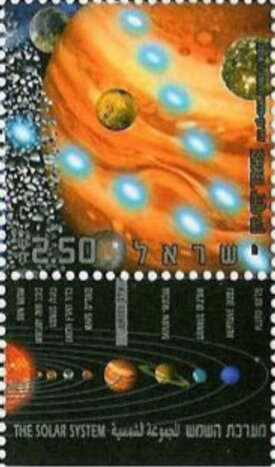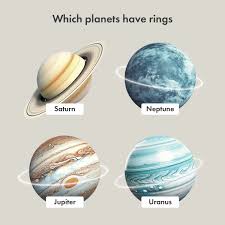Stamp: Jupiter, moons and asteroids (Israel 2006)
Jupiter, moons and asteroids (Israel 2006)
08 May (Israel ) within release The Solar System goes into circulation Stamp Jupiter, moons and asteroids face value 2.50 Israeli new shekel
| Stamp Jupiter, moons and asteroids in catalogues | |
|---|---|
| Michel: | Mi: IL 1866T |
| Stamp Number: | Sn: IL 1643dT |
| Yvert et Tellier: | Yt: IL 1789T |
| Stanley Gibbons: | Sg: IL 1780T |
Stamp is square format.
stamp from mini-sheetAlso in the issue The Solar System:
- Stamp - Sun, Mercury and Venus face value 2.50;
- Stamp - Mercury, Venus and Jupiter face value 2.50;
- Stamp - Neptune, Pluto and Moons face value 2.50;
- Stamp - Saturnus and Moon face value 2.50;
- Souvenir Sheet - Souvenir sheet face value 15;
- Stamp - Earth, Moon and Mars face value 2.50;
- Stamp - Earth, Moon and Mars face value 2.50;
- First Day Cover - Saturnus and Moon / Mercury, Venus and Jupiter / Earth, Moon face value 7.50;
- Stamp - Neptune, Pluto and moons face value 2.50;
- Stamp - Jupiter, moons and asteroids face value 2.50;
- Booklet - Saturn, moon, Sun and asteroids face value 15;
- Stamp - Sun, Mercury and Venus face value 2.50;
- Stamp - Uranus, moons, asteroid, Saturn face value 2.50;
- Stamp - Earth, Moon and Mars face value 2.50;
- Stamp - Saturn, moon, Sun and asteroids face value 2.50;
- Stamp with Collectible Margin - Earth, Moon and Mars face value 2.50;
- Stamp - Jupiter, moons and asteroids face value 2.50;
- Stamp with Collectible Margin - Neptune, Pluto and moons face value 2.50;
- Stamp with Collectible Margin - Saturn, moon, Sun and asteroids face value 2.50;
- Stamp with Collectible Margin - Sun, Mercury and Venus face value 2.50;
- Stamp with Collectible Margin - Uranus, moons, asteroids, Saturn face value 2.50;
Stamp Jupiter, moons and asteroids it reflects the thematic directions:
The Moon is Earth's only natural satellite. It orbits at an average distance of 384,400 km (238,900 mi), about 30 times the diameter of Earth. Tidal forces between Earth and the Moon have over time synchronized the Moon's orbital period (lunar month) with its rotation period (lunar day) at 29.5 Earth days, causing the same side of the Moon to always face Earth. The Moon's gravitational pull – and to a lesser extent, the Sun's – are the main drivers of Earth's tides.
Outer space (or simply space) is the expanse that exists beyond Earth's atmosphere and between celestial bodies. It contains ultra-low levels of particle densities, constituting a near-perfect vacuum of predominantly hydrogen and helium plasma, permeated by electromagnetic radiation, cosmic rays, neutrinos, magnetic fields and dust. The baseline temperature of outer space, as set by the background radiation from the Big Bang, is 2.7 kelvins (−270 °C; −455 °F)
A planet is a large, rounded astronomical body that is generally required to be in orbit around a star, stellar remnant, or brown dwarf, and is not one itself. The Solar System has eight planets by the most restrictive definition of the term: the terrestrial planets Mercury, Venus, Earth, and Mars, and the giant planets Jupiter, Saturn, Uranus, and Neptune. The best available theory of planet formation is the nebular hypothesis, which posits that an interstellar cloud collapses out of a nebula to create a young protostar orbited by a protoplanetary disk. Planets grow in this disk by the gradual accumulation of material driven by gravity, a process called accretion.



